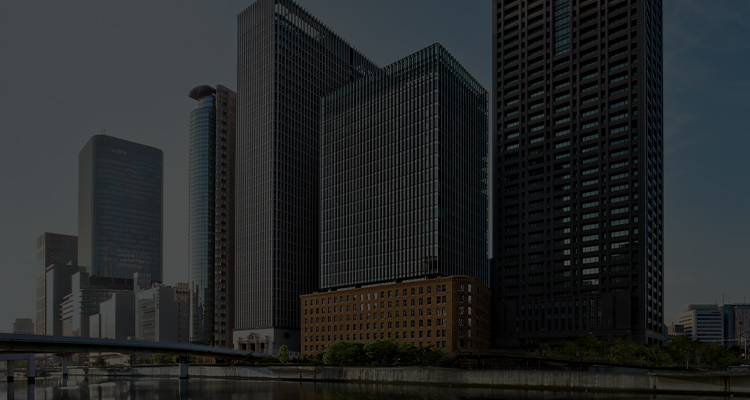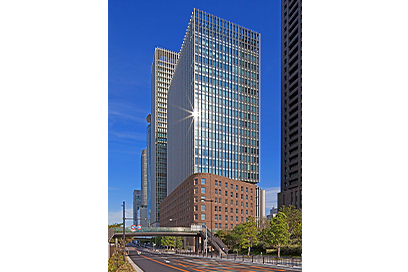
Chapter 5 Transformation
2004
2023
Section 2. Expanding Our Business
6. The 3 Nakanoshima Joint Development Project and the Completion of the Daibiru-Honkan Building
In October 2009, following the completion of the Nakanoshima Daibiru Building, Daibiru announced plans for the construction of the Nakanoshima Daibiru West Building (tentative name), which would be the rebuilt Daibiru-Honkan Building as the third phase of the project. The Daibiru-Honkan Building had been one of Osaka’s most distinctive office buildings since the early 1900s, and it was well-known as a building with significant historical value with respect to the history of modern architecture. Although there was much regret about its demolition, rebuilding it in order to improve the value of the 3 Nakanoshima neighborhood was judged to be unavoidable. Even so, Daibiru reused the bricks and stone ornaments from the original building as much as possible during the rebuild in order to recreate the look of the old Daibiru-Honkan Building. Furthermore, in conjunction with completion of the Daibiru-Honkan Building, Daibiru and Kanden Realty jointly developed Nakanoshima Shiki-no-oka on the west side of the property as a space for relaxation and experiencing nature throughout the four seasons.
Nikken Sekkei designed the building and supervised the project, and Obayashi Corporation was responsible for construction, which got underway in November 2009. The Nakanoshima Daibiru West Building had 22 aboveground floors, two underground floors, and two penthouse floors. A completion ceremony was held for the “Daibiru-Honkan Building” on March 21, 2013, and the commercial zone opened in July of that year. Obayashi Corporation and other major companies decided to occupy the office zone.
Nakanoshima Shiki-no-oka and the Daibiru-Honkan Building were highly acclaimed and received numerous awards as an area where the city and natural environment were in harmony.
Later, in September 2013, the company constructed the Nakanoshima 3-Chome Pedestrian Bridge, which connects Nakanoshima Shiki-no-oka to the Dojima River promenade, as a joint project with Kanden Realty & Development, and transferred it to the City of Osaka. Furthermore, in January 2014, the company constructed a pedestrian bridge in 3 Nakanoshima that connects to the Tosabori River promenade as a joint project with Mitsui Fudosan Co., Ltd. and Kanden Realty & Development. In June 2021, the company upgraded the pedestrian bridge that connects to Nakanoshima 4-Chome as a joint project with the City of Osaka and Kanden Realty & Development. These projects completed the pedestrian path network in the Nakanoshima 3-Chome area (covering the western Nakanoshima area).
| Property overview | Daibiru-Honkan Building |
|---|---|
| Address | 3-6-32 Nakanoshima, Kita-ku, Osaka |
| Date of completion | February 2013 |
| Construction | steel-frame construction with some parts steel-frame reinforced concrete construction and reinforced concrete construction |
| Size | 22 aboveground floors, two underground floors, two penthouse floors |
| Site area | 10,098 m2 (This is the portion of the 3 Nakanoshima Joint Development Project area that is owned by Daibiru.) |
| Total floor area | 48,198 m2 |
-
1923 1944 Beginnings
-
Section 2. Launching a Building Management Business
-
Section 4. Business Development in Wartime
-
1945 1957 Reconstruction
-
Section 2. Our Buildings Reopen
-
1958 1988 Development
-
Section 1. Expanding the Building Management Business
- 1. The End of the Requisition of the Hibiya Daibiru Buildings
- 2. Upgrading the Facilities of the Daibiru Buildings and Damage Caused by the 2nd Muroto Typhoon
- 3. The Completion of the North Wing of the Shin-Daibiru Building
- 4. The Completion of the Yaesu Daibiru Building
- 5. The Acquisition of the Midosuji Daibiru Building
- 6. The Completion of the Kojimachi Daibiru Building
- 7. The Completion of the Uchisaiwaicho Daibiru Building
- 8. The Completion of the Dojima Daibiru Building
- 9. The Completion of the Awajimachi Daibiru Building
- 10. The Completion of the Mita-Nitto Daibiru Building
-
Section 2. Expanding the Business Through M&A
-
-
1989 2003 Expansion (1989–2003)
-
Section 1. Creating New Urban Spaces
- 1. The Bubble Economy and Daibiru
- 2. The Hibiya Daibiru Rebuilding Project
- 3. The Completion of the Rebuild
- 4. The Start and Execution of Renovation Plans
- 5. The Completion of the Kita-Umeda Daibiru Building
- 6. The Completion of the Yodoyabashi Daibiru Building
- 7. The Completion of the Estate Tosabori Building
- 8. The Completion of the Umeda Daibiru Building
- 9. The Completion of Violette Takarazuka
- 10. The Shinjuku Daibiru Building and Shiba Daibiru Building Acquisitions
-
Section 2. The Development of a New Corporate Identity and a Name Change
-
Section 3. Disaster Preparedness and Risk Management
-
-
2004 2023 Transformation (2004–2023)
-
Section 1. Becoming a Consolidated Subsidiary of Mitsui O.S.K. Lines and Promoting Management Plans
- 1. Becoming a Consolidated Subsidiary of Mitsui O.S.K. Lines
- 2. Concentrating Investment in the Tokyo Area
- 3. Expanding into Other Countries and Japanese Regions
- 4. Establishing Daibiru 3D-Project Phase I, a Medium-Term Management Plan
- 5. Establishing Our Management Philosophy and Mission Statement
- 6. Establishing Daibiru-3D Project Phase II, a New Medium-Term Management Plan
- 7. Ongoing Establishment of New Medium-Term Management Plans
-
Section 2. Expanding Our Business
- 1. The Akihabara Station Redevelopment Project and the Completion of the Akihabara Daibiru Building
- 2. The Acquisition of the Toranomon Daibiru Building
- 3. The 3 Nakanoshima Joint Development Project and the Completion of the Nakanoshima Daibiru Building
- 4. The Completion of the Tosabori Daibiru Building
- 5. The Acquisition of Aoyama Rise Square
- 6. The 3 Nakanoshima Joint Development Project and the Completion of the Daibiru-Honkan Building
- 7. Rebuilding the Shin-Daibiru Building
- 8. Renovation Work
- 9. Multiple Awards
- 10. Delving into Commercial Facilities
- 11. Acquiring a Partial Interest in the Seavans South Building
- 12. Expansion to Sapporo
- 13. Selling Seven Residential Properties
- 14. Starting the Rebuild of the Midosuji Daibiru Building
- 15. Starting the Rebuild of the Yaesu Daibiru Building
-
Section 3. Overseas Business Expansion
-
Section 4. Further Strengthening of the Corporate Structure and Group Reorganization
-
Section 5. Harmonious Coexistence with Society
- 1. Developing a Compliance System
- 2. Developing an Internal Control System
- 3. Risk Management Measures
- 4. Sustainability Initiatives
- 5. Social Contribution and Cultural Support Initiatives
- 6. Environmental Initiatives
- 7. Working Style Reform Initiatives
- 8. Launching the Brand Development Project
- 9. Launching the Head Office Renovation Project
-
Section 6. Toward Our 100th Anniversary and Beyond
- 1. Becoming a Full Subsidiary of Mitsui O.S.K. Lines
- 2. Acquiring a Partial Interest in Otemachi First Square
- 3. Acquiring a Partial Interest in the Otemon Tower / ENEOS Building
- 4. Investment in an SPC for Logistics Facilities in the Nishinomiya Area
- 5. Project Participation in the United States
- 6. Project Development in Melbourne, Australia
- 7. Formulation of a New Medium- and Long-Term Management Plan
- 8. Implementing 100th Anniversary Projects
- 9. For Future Generations
-




